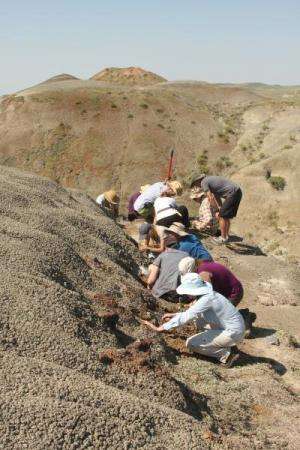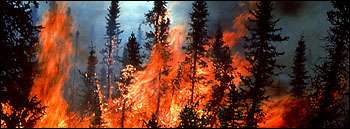Ancient forest fire gives clues to dinosaurs final days

Researchers at McGill University have excavated the first fossil evidence of forest fire ecology, revealing forests still recover from wildfires the same way today as they did during the reign of the dinosaurs.
66 million years ago, just before the last great mass extinction on Earth, a great fire ravaged what is now southern Saskatechwan, Canada. During this critical period, known as the Maastrichtian, intercontinental seaways were receding, the oceans were undergoing acidification, and mass volcanism worked with the tempestuous climate to induce high biotic stress.
The fossilized charcoal discovered among the flora provide a comparative timeline of the plant regrowth in the region for the first time, lending important insight into the biodiversity patterns just before the extinction event.
"Excavating plant fossils preserved in rocks deposited during the last days of the dinosaurs, we found some preserved with abundant fossilized charcoal and others without it. From this, we were able to reconstruct what the Cretaceous forests looked like with and without fire disturbance", says Hans Larsson, Canada Research Chair in Macroevolution at McGill University.
As is the case with modern forests, angiosperm plants such as alder, birch, and sassafras dominated the areas most recently razed with wildfire. Sequoia and ginkgo were present among the mature and more biodiverse forests.
"Forest fire ecology appears to be shockingly unchanged for at least the past 66 million years," Larsson told Astrobio. "This speaks to the robustness of this ecological response."

The stone-encased forest fire and the abundance of plant fossils unearthed during the excavation create a unique snapshot of the climatic conditions on Earth just prior to the demise of dinosaurs. Using Leaf Margin Analysis and the Climate Leaf Analysis Multivariate Program (CLAMP), Larsson and his team were able to determine the ancient region was once more hot and humid.
"We now have evidence that the mean annual temperature in southern Saskatchewan was 10-12 degrees Celsius warmer than today, with almost six times as much precipitation," says Emily Bamforth of the Royal Saskatchewan Museum and the study's first author.
But what can that reveal to us about climate change today?
"It's another datapoint in the immense ancient climate record that shows climate has fluctuated quite a bit over the years," Larsson told Astrobio. "The higher temperatures supported high biodiversities and are not associated with ecological disasters, like current climate change is forecasting. That's likely because this ancient 'natural' climate change happened over longer time scales and biodiversity could evolve in step with it," he said.
For more than thirty years, scientists have debated the actual cause of the end-Cretaceous mass extinction. That a meteorite struck the Earth is but a piece—albeit an import piece—to the puzzle of what actually caused the event. There is significant evidence that a gradual, long-term extinction was already in effect before the meteorite made impact and sufficiently wiped the dinosaurs from the face of the Earth.
"We won't be able to fully understand the extinction dynamics until we understand what normal ecological processes were going on in the background," says Larsson.
More information: astrobiology.nasa.gov/roadmap/
Source: Astrobio.net
This story is republished courtesy of NASA's Astrobiology Magazine. Explore the Earth and beyond at www.astrobio.net .

















